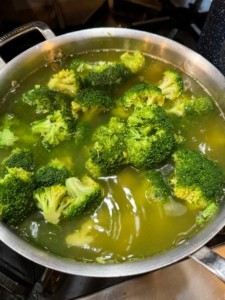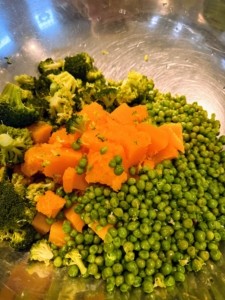Making your own dog food at home is a fantastic way to ensure your furry friend is getting the most nutritious and delicious meals possible. At FOODS.EDU.VN, we are here to guide you through crafting wholesome, balanced recipes that cater specifically to your dog’s needs, using fresh, high-quality ingredients. Learn how to create DIY dog food recipes, prepare healthy homemade meals, and understand canine nutrition for a happier, healthier pup.
1. Why Make Dog Food at Home? The Tail-Wagging Benefits
Choosing to prepare your dog’s meals at home unlocks a world of benefits, from enhanced control over ingredients to the joy of seeing your dog thrive on a diet crafted with love. It’s more than just a trend; it’s a commitment to your dog’s well-being.
1.1. Complete Control Over Ingredients
When you make dog food at home, you know exactly what goes into your dog’s bowl. You can select fresh, whole foods and avoid the artificial preservatives, colors, and fillers often found in commercial dog food.
1.2. Addressing Allergies and Sensitivities
Homemade dog food is ideal for dogs with allergies or food sensitivities. You can easily eliminate common allergens like wheat, corn, soy, or specific proteins and tailor the diet to suit your dog’s unique needs. For example, if your dog is sensitive to chicken, you can opt for lamb, fish, or even venison.
1.3. Boosting Nutrition and Health
Home-prepared dog food can be packed with vital nutrients. You can include a variety of lean proteins, healthy fats, and nutrient-rich vegetables, all contributing to a balanced and wholesome diet that supports optimal health.
1.4. Cost-Effectiveness in the Long Run
While the initial investment in ingredients might seem higher, homemade dog food can be more cost-effective over time, especially if you buy in bulk, utilize seasonal produce, and avoid expensive commercial brands.
1.5. Bonding Through Cooking
Preparing homemade dog food can be a rewarding experience that strengthens the bond between you and your pet. The joy of seeing your dog eagerly devour a meal you prepared with love is unmatched.
2. Understanding Canine Nutritional Needs: A Balanced Bowl
Before diving into recipes, it’s crucial to understand what constitutes a balanced diet for dogs. A well-rounded homemade dog food recipe should include the following components:
2.1. Protein: The Building Block
Protein is essential for muscle development, tissue repair, and overall vitality. Good sources include lean meats like chicken, turkey, beef, and fish. Plant-based options include lentils and beans, but these should be combined carefully to ensure a complete amino acid profile.
2.2. Carbohydrates: Energy Source
Carbohydrates provide energy for your dog’s daily activities. Opt for complex carbohydrates like sweet potatoes, brown rice, quinoa, and oats. These are digested slowly, providing a steady energy source.
2.3. Healthy Fats: The Glossy Coat Secret
Healthy fats are vital for a shiny coat, healthy skin, and proper brain function. Include sources like fish oil, flaxseed oil, and coconut oil in moderation.
2.4. Vitamins and Minerals: Essential Micronutrients
Vitamins and minerals are necessary for various bodily functions, including immune support, bone health, and nerve function. A variety of colorful vegetables like carrots, broccoli, and spinach can provide these essential micronutrients.
2.5. Fiber: Digestive Health
Fiber aids in digestion and helps maintain regular bowel movements. Good sources include pumpkin, sweet potatoes, and leafy greens.
Table 1: Essential Nutrients for Dogs
| Nutrient | Benefits | Sources |
|---|---|---|
| Protein | Muscle development, tissue repair, enzyme production | Chicken, turkey, beef, fish, eggs, lentils |
| Carbohydrates | Energy source, supports brain function | Sweet potatoes, brown rice, quinoa, oats, barley |
| Healthy Fats | Healthy skin and coat, brain function, supports immune system | Fish oil, flaxseed oil, coconut oil, olive oil |
| Vitamins & Minerals | Supports immune system, bone health, nerve function, overall health | Carrots, broccoli, spinach, blueberries, apples, bananas |
| Fiber | Aids digestion, promotes regular bowel movements | Pumpkin, sweet potatoes, leafy greens, apples |




3. Essential Equipment and Tools: Setting Up Your Kitchen
To make dog food efficiently and safely, having the right equipment is essential. Here’s a list of must-have tools:
3.1. Large Cooking Pots
For cooking grains, vegetables, and proteins in large batches. Stainless steel is a durable and safe option.
3.2. Food Processor or Blender
To grind or blend ingredients to the desired consistency. This is particularly useful for dogs who prefer their food finely ground or have difficulty chewing.
3.3. Cutting Boards
Designate separate cutting boards for raw meats and vegetables to prevent cross-contamination.
3.4. Knives
A set of sharp knives for chopping and dicing ingredients.
3.5. Measuring Cups and Spoons
For accurate ingredient measurements to ensure a balanced diet.
3.6. Storage Containers
Airtight containers for storing prepared dog food in the refrigerator or freezer.
3.7. Kitchen Scale
To weigh ingredients accurately, especially when following specific recipes.
3.8. Slow Cooker or Instant Pot
Optional, but useful for cooking large batches of food with minimal effort.
4. Safety First: Handling and Storing Homemade Dog Food
Safety is paramount when preparing homemade dog food. Follow these guidelines to ensure your dog’s food is safe and nutritious:
4.1. Hygiene Practices
Always wash your hands thoroughly before and after handling raw ingredients. Clean all surfaces and utensils with hot, soapy water.
4.2. Cooking Meats Thoroughly
Ensure all meats are cooked to a safe internal temperature to kill harmful bacteria. Use a meat thermometer to verify.
4.3. Avoiding Toxic Ingredients
Be aware of ingredients that are toxic to dogs, such as chocolate, onions, garlic, grapes, raisins, and avocados. Keep these out of your dog’s food.
4.4. Proper Storage
Store homemade dog food in airtight containers in the refrigerator for up to 3-4 days or in the freezer for up to 2-3 months. Label each container with the contents and preparation date.
4.5. Thawing Safely
Thaw frozen dog food in the refrigerator. Do not leave it at room temperature, as this can promote bacterial growth.
5. Easy Homemade Dog Food Recipes: A Culinary Journey
Now, let’s explore some easy and nutritious homemade dog food recipes that you can prepare in your kitchen.
5.1. Chicken and Veggie Delight
This recipe is a great starting point, offering a balanced mix of protein, carbohydrates, and essential nutrients.
Ingredients:
- 1.5 lbs boneless, skinless chicken breast
- 1 cup brown rice
- 2 cups mixed vegetables (carrots, peas, broccoli)
- 4 cups water
- 1 tbsp fish oil
Instructions:
- Cook the brown rice according to package directions.
- Boil or steam the chicken until fully cooked. Shred or dice the chicken into small pieces.
- Steam or boil the mixed vegetables until tender.
- Combine the cooked rice, chicken, and vegetables in a large bowl.
- Add the fish oil and mix well.
- Allow the mixture to cool before serving.
Nutritional Benefits:
- Chicken: Excellent source of lean protein.
- Brown Rice: Provides sustained energy and fiber.
- Carrots: Rich in beta-carotene, which supports eye health.
- Peas: Good source of vitamins and minerals.
- Broccoli: High in fiber and antioxidants.
- Fish Oil: Provides omega-3 fatty acids for healthy skin and coat.
5.2. Beef and Sweet Potato Bowl
This recipe is packed with protein and fiber, ideal for active dogs.
Ingredients:
- 1.5 lbs ground beef
- 2 medium sweet potatoes, peeled and diced
- 1 cup green beans, chopped
- 4 cups water
- 1 tbsp coconut oil
Instructions:
- Brown the ground beef in a large pot. Drain off any excess fat.
- Add the diced sweet potatoes, chopped green beans, and water to the pot.
- Bring to a boil, then reduce heat and simmer for 20-25 minutes, or until the sweet potatoes are tender.
- Stir in the coconut oil.
- Allow the mixture to cool before serving.
Nutritional Benefits:
- Ground Beef: Provides high-quality protein and iron.
- Sweet Potatoes: Excellent source of fiber, vitamin A, and antioxidants.
- Green Beans: Good source of vitamins and minerals.
- Coconut Oil: Supports healthy skin and coat.
5.3. Fish and Quinoa Feast
This recipe is great for dogs with sensitive stomachs or allergies, as it is grain-free and easy to digest.
Ingredients:
- 1.5 lbs salmon fillets, boneless and skinless
- 1 cup quinoa
- 2 cups spinach, chopped
- 4 cups water
- 1 tbsp flaxseed oil
Instructions:
- Cook the quinoa according to package directions.
- Bake, steam, or poach the salmon until fully cooked. Flake the salmon into small pieces.
- Steam the chopped spinach until wilted.
- Combine the cooked quinoa, salmon, and spinach in a large bowl.
- Add the flaxseed oil and mix well.
- Allow the mixture to cool before serving.
Nutritional Benefits:
- Salmon: Rich in omega-3 fatty acids, which promote healthy skin and coat.
- Quinoa: A complete protein source and gluten-free grain.
- Spinach: Excellent source of vitamins and minerals.
- Flaxseed Oil: Provides additional omega-3 fatty acids and supports healthy digestion.
6. Customizing Recipes: Tailoring to Your Dog’s Needs
One of the greatest advantages of making dog food at home is the ability to customize recipes to meet your dog’s specific needs. Here’s how to tailor recipes effectively:
6.1. Considering Age and Activity Level
Puppies, adult dogs, and senior dogs have different nutritional needs. Puppies require more protein and calories for growth, while senior dogs may need fewer calories and more fiber. Active dogs need more energy-dense foods compared to less active ones.
6.2. Adjusting for Weight Management
If your dog needs to lose weight, reduce the portion sizes and increase the fiber content. For dogs that need to gain weight, increase the protein and healthy fat content.
6.3. Addressing Health Conditions
If your dog has specific health conditions like kidney disease or diabetes, consult with your veterinarian to determine the appropriate dietary modifications.
6.4. Rotating Ingredients
Varying the ingredients in your dog’s diet can help prevent allergies and ensure a wider range of nutrients. Try different proteins, carbohydrates, and vegetables regularly.
6.5. Consulting with a Veterinarian or Canine Nutritionist
Before making significant changes to your dog’s diet, it’s always best to consult with a veterinarian or a certified canine nutritionist. They can provide personalized recommendations based on your dog’s individual health status and nutritional needs.
7. Supplements: Boosting the Nutritional Value
While homemade dog food can be highly nutritious, some dogs may benefit from additional supplements to ensure they are getting all the nutrients they need.
7.1. Multivitamins
A daily multivitamin can help fill any nutritional gaps, especially if your dog has specific dietary restrictions or health conditions.
7.2. Calcium
Important for bone health, especially for puppies and pregnant or lactating dogs.
7.3. Omega-3 Fatty Acids
Supplements like fish oil or flaxseed oil can help improve skin and coat health, reduce inflammation, and support brain function.
7.4. Probiotics
Probiotics can help maintain a healthy gut microbiome, improving digestion and boosting the immune system.
7.5. Digestive Enzymes
These can aid in the digestion and absorption of nutrients, particularly beneficial for older dogs or those with digestive issues.
8. Transitioning Your Dog to Homemade Food: A Gradual Shift
Switching your dog from commercial food to homemade food should be done gradually to avoid digestive upset. Here’s a step-by-step guide:
8.1. Start Slowly
Begin by replacing a small portion of your dog’s current food with the homemade food. Start with about 10-20% of the total meal.
8.2. Gradually Increase
Over the next 7-10 days, gradually increase the amount of homemade food while decreasing the amount of commercial food.
8.3. Monitor Your Dog’s Response
Watch for any signs of digestive upset, such as diarrhea, vomiting, or loss of appetite. If you notice any issues, slow down the transition or consult with your veterinarian.
8.4. Full Transition
By the end of the transition period, your dog should be eating 100% homemade food.
8.5. Patience is Key
Some dogs may take longer to adjust to homemade food than others. Be patient and persistent, and your dog will eventually adapt to the new diet.
Table 2: Transitioning to Homemade Dog Food
| Day | Homemade Food | Commercial Food |
|---|---|---|
| 1-2 | 10-20% | 80-90% |
| 3-4 | 30-40% | 60-70% |
| 5-6 | 50-60% | 40-50% |
| 7-8 | 70-80% | 20-30% |
| 9-10 | 100% | 0% |
9. Common Mistakes to Avoid: Ensuring a Healthy Diet
While making dog food at home is rewarding, it’s essential to avoid common mistakes that can compromise your dog’s health.
9.1. Feeding Unbalanced Meals
Ensure that each meal contains the right balance of protein, carbohydrates, healthy fats, vitamins, and minerals. Relying too heavily on one ingredient can lead to nutritional deficiencies.
9.2. Overlooking Toxic Ingredients
Always double-check that your recipes do not include any ingredients that are toxic to dogs, such as chocolate, onions, garlic, grapes, and raisins.
9.3. Not Cooking Meats Thoroughly
Raw or undercooked meats can harbor harmful bacteria. Always cook meats to a safe internal temperature.
9.4. Neglecting Portion Control
Overfeeding can lead to obesity, while underfeeding can result in malnutrition. Adjust portion sizes based on your dog’s age, activity level, and health condition.
9.5. Ignoring Veterinary Advice
Consult with your veterinarian or a certified canine nutritionist before making significant changes to your dog’s diet. They can provide personalized recommendations based on your dog’s individual needs.
10. Addressing Common Concerns: FAQ on Homemade Dog Food
Here are answers to some frequently asked questions about making dog food at home:
10.1. Is homemade dog food safe?
Yes, homemade dog food can be safe and nutritious if prepared correctly with balanced recipes and proper hygiene practices.
10.2. How do I know if my dog is getting enough nutrients?
Monitor your dog’s overall health, including their weight, energy levels, coat condition, and stool quality. Regular check-ups with your veterinarian can also help assess their nutritional status.
10.3. Can I use human-grade ingredients?
Yes, using high-quality, human-grade ingredients is recommended for homemade dog food.
10.4. How long does homemade dog food last?
Homemade dog food can be stored in the refrigerator for up to 3-4 days or in the freezer for up to 2-3 months.
10.5. Can I make homemade dog treats?
Yes, there are many simple and healthy recipes for homemade dog treats that you can find online or in canine cookbooks.
10.6. What are some signs that my dog is not tolerating homemade food?
Signs of intolerance can include diarrhea, vomiting, loss of appetite, skin irritation, or excessive gas.
10.7. Do I need to add supplements to homemade dog food?
Some dogs may benefit from supplements to ensure they are getting all the necessary nutrients, especially if they have specific dietary needs or health conditions.
10.8. Can I make homemade dog food for puppies?
Yes, but puppies have different nutritional needs than adult dogs. Consult with your veterinarian or a canine nutritionist to ensure the recipes are appropriate for puppies.
10.9. How often should I feed my dog homemade food?
The feeding frequency depends on your dog’s age, size, and activity level. Generally, adult dogs should be fed twice a day, while puppies may need to be fed three to four times a day.
10.10. What if my dog is a picky eater?
Try different recipes and ingredients to find what your dog enjoys. You can also try warming the food slightly to enhance its aroma.
Conclusion: The Path to a Healthier, Happier Dog
Making dog food at home is a labor of love that pays off in the improved health and happiness of your furry friend. By understanding canine nutritional needs, using safe practices, and tailoring recipes to your dog’s unique requirements, you can provide them with a diet that supports their overall well-being.
Ready to dive deeper into the world of homemade dog food and discover more expert tips, delicious recipes, and nutritional guidance? Visit FOODS.EDU.VN today! Our comprehensive resources and expert advice will empower you to create the best possible diet for your canine companion. Contact us at 1946 Campus Dr, Hyde Park, NY 12538, United States or Whatsapp: +1 845-452-9600. Your dog’s health and happiness are just a click away at foods.edu.vn!